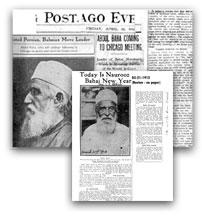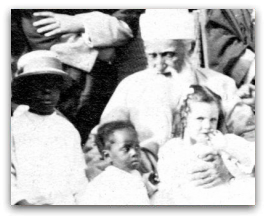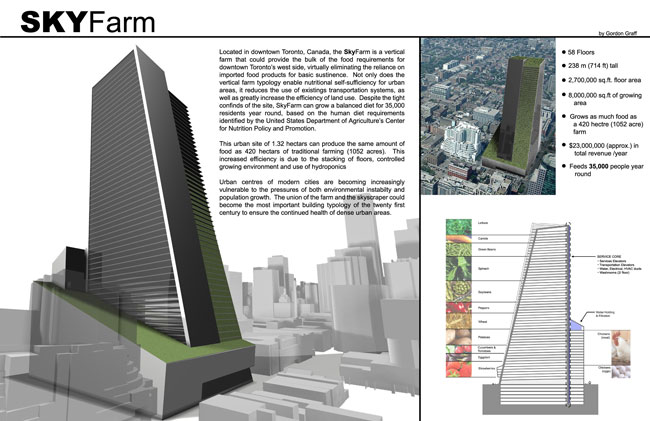 |
| Click On Me! |
The year 1912, said US presidential candidate Eugene Debs, “is a year supreme with possibilities.” A fiercely contested election challenged Americans to decide what kind of country they wanted. Minorities and women fought for civil rights. Workers faced off against corporations. Soldiers landed on foreign shores, sparking debate on the nation’s role in the world. Did Americans really believe—like Theodore Roosevelt— that “The welfare of each of us is dependent fundamentally upon the welfare of all of us”?
On April 11, 1912, a new voice joined the conversation. It belonged to ‘Abdu’l-Bahá.
It was the unlikeliest of voices. ‘Abdu’l-Bahá had just been released by the Turkish government after 40 years as a prisoner of conscience. For 239 days he traveled across America, speaking about issues that still define us. He reached across political, religious, racial, class, and gender lines to confront Americans with a vision of human nature, social unity, and the nation’s future that was 100 years ahead of its time.
In 1912, the country was torn with racial division, and “separate but equal” was the highest level of interracial relations to which the nation aspired. ‘Abdu’l-Bahá challenged America to go beyond tolerance, to embrace diversity completely, and to demolish racial barriers in law, education and even marriage.
Unity in Diversity: Watchword of the Bahá'í Community
Perhaps the most prominent social message that ‘Abdu’l-Bahá brought to the West was the need for international peace, which he called “the most momentous question of this day.” While much of the popular discussion involved the political requisites to peace, ‘Abdu’l-Bahá focused on social and spiritual issues, linking universal peace with such topics as women’s suffrage, a world tribunal, collective security, the necessity of religious unity and the need for justice.
‘Abdu’l-Bahá described gender equality through the powerful analogy of a bird attempting to fly:
Ending Extremes of Wealth and PovertyThe world of humanity is possessed of two wings: the male and the female. So long as these two wings are not equivalent in strength, the bird will not fly. Until womankind reaches the same degree as man, until she enjoys the same arena of activity … humanity cannot wing its way to heights of real attainment.
On the eve of ‘Abdu’l-Bahás journey across America, a new industrial order had emerged, creating nationwide prosperity, but also exacerbating crushing poverty and inequity. Publishers and industrialists grew very wealthy providing newspapers, magazines, automobiles and steel, building the railroads that crisscrossed the U.S. and the ships that transported American manufactured goods to Europe. In the midst of such vast wealth, the poor languished in crowded and often disease-ridden urban housing. The first decades of the 20th century saw huge numbers of children working in mines, glass factories, textiles, agriculture, canneries, and as newsboys, messengers, bootblacks, and peddlers. In 1904, the National Child Labor Committee was formed and a national child labor reform campaign began, but a law to actually prevent child labor would not be passed by Congress until the mid 1930s.
The year 1912 saw America with a population of 92 million, with a low 2% unemployment rate, but the chasm between the wealthy and the poor was impassible. Workplaces were profoundly unsafe. On the railroads alone, between 1890 and 1917, 72,000 workers were killed and more than 2 million injured. In addition, there was no social safety net—worker’s compensation was a new idea, passed by just 10 states by 1911. Neither Social Security, Medicare, nor Aid to Families with Dependent Children existed—so the elderly, widows, orphans and the ill were left to their own devices, meager as they were. Partly due to these social disparities, worsened by poor sanitation and a lack of good public health practices,U.S. life expectancy was on average just 48 years for men and 52 years for women.
Labor unions grew in size and influence as the middle classes became more unhappy and restless with the status quo. Poverty was on the rise, industrial monopolies continued to increase despite the Sherman Antitrust Act of 1890, safety for workers in the workplace was largely dismissed as irrelevant, and children were in the workplace in their thousands. Nearly 20% of urban children were undernourished and only one-third were enrolled in elementary school. Immigrants had flooded the cities, many—including Poles, Finns from Russia, and Macedonians and Bulgarians from Turkey—fleeing political or religious oppression. Others, like the Irish, fled famine and poverty, swelling the ranks of the poor.
Social reforms in the 1940s took the first small steps to redress these inequities through the Social Security system, whereby the aged would receive an income set aside from their earnings, and the poor would receive medical care. The U.S. GI bill after World War II enabled thousands of returning military men and women to obtain college degrees and rise to serve their countries in all the professions.
Labor unions grew in size and influence as the middle classes became more unhappy and restless with the status quo. Poverty was on the rise, industrial monopolies continued to increase despite the Sherman Antitrust Act of 1890, safety for workers in the workplace was largely dismissed as irrelevant, and children were in the workplace in their thousands. Nearly 20% of urban children were undernourished and only one-third were enrolled in elementary school. Immigrants had flooded the cities, many—including Poles, Finns from Russia, and Macedonians and Bulgarians from Turkey—fleeing political or religious oppression. Others, like the Irish, fled famine and poverty, swelling the ranks of the poor.
Social reforms in the 1940s took the first small steps to redress these inequities through the Social Security system, whereby the aged would receive an income set aside from their earnings, and the poor would receive medical care. The U.S. GI bill after World War II enabled thousands of returning military men and women to obtain college degrees and rise to serve their countries in all the professions.
Below are some great links to obtain more information:
239 Days In America
US Bahá'í Community: Commemoration of the Centenary of 'Abdu'l-Bahá's Visit to America
Talks Given by 'Abdu'l-Bahá
Portraits of 'Abdu'l-Bahá
Photographs of 'Abdu'l-Bahá in the West
239 Days: 'Abdu'l-Bahá's Journey in America, By: Allan L. Ward
An Excerpt from 239 Days: 'Abdu'l-Bahá's Journey in America:
Chapter 2
First Days in America: New York City
The next day was Thursday, April 11, 1912, 'Abdu'l-Bahá's first day in America. As the Cedric came up the bay, reporters went out on the tugboat to board the ship at quarantine in order to interview 'Abdu'l-Bahá. Among them was Wendell Phillips Dodge, of the New York City News Association, whose report was sent out through the Associated Press. He wrote:
When the ship news reporters boarded the Cedric down the bay 'Abdu'l-Bahá was found on the upper deck, standing where he could see the pilot, his long, flowing oriental robe flapping in the breeze... His face was light itself as he scanned the harbor and greeted the reporters. His first words were about the press, saying: "The pages of swiftly appearing newspapers are indeed the mirror of the world... But it behooveth the editors of the newspapers to be sanctified from the prejudice of egotism and desire, and to be adorned with the ornament of equity and justice."When the ship was abreast the Statue of Liberty, standing erect and facing it, 'Abdu'l-Bahá held his arms wide apart in salutation, and said: "There is the new world's symbol of liberty and freedom. After being forty years a prisoner I can tell you that freedom is not a matter of place. It is a condition. Unless one accept dire vicissitudes he will not attain. When one is released from the prison of self, that is indeed a release."... The ship now pointed its nose up the North River, and gazing ... at the ... skyscrapers, (He said): "These are the minarets of Western World commerce and industry... The ship now reached its pier, where were anxiously waiting several hundred Bahá'ís ... who had been craning their necks down the river for a first sight of him since early morning.'
- Please enjoy this wealth of information.
 |
| Click On Me! |
 |
| A Photograph of 'Abdu'l-Bahá |
‘Abdu’l-Bahá’s journeys in America lasted 239 days between April and December 1912. While much of his time was spent in the major metropolitan centers of the country, a number of small towns were also on the itinerary, and indeed ‘Abdu’l-Bahá never seemed to be as interested in material development as in spiritual capacity. Most of His cross-country travels were by train, which was the most convenient form of long-distance travel at the time. He spent 10 days in Canada, and a little over a month on the West coast, with the rest of the time shared among the cities and towns of the Eastern and Central United States.
---------
Below is a video that contains 'Abdu'l-Bahá's message in more depth, concluding this article. Please enjoy.







